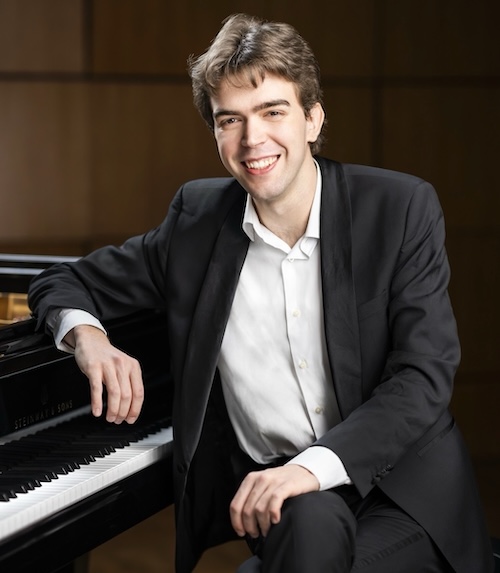Performances
Seraphic Fire wraps season with rewarding 20th-century works
A new style of art, architecture, and furniture design flourished in […]
Palm Beach Symphony closes season with a feast of Beethoven
The Palm Beach Symphony ended its 50th season Thursday night with […]
Chopin provides the highlights in Lang Lang’s mixed recital at Arsht Center
Lang Lang has been a major presence on the world’s concert […]
Articles
Seraphic Fire conductor to explore music of 20 women composers, from Hildegard to Shaw
“We are used to hearing stories of women, the history of […]
Concert review
Smit brings individual touch to minor-key drama of Beethoven and Schubert
The sonatas in a minor key of Beethoven and Schubert have a special resonance and emotional depth. Two of those scores provided the centerpiece of the recital by Spanish-Dutch pianist Albert Cano Smit for the Miami International Piano Festival Sunday afternoon at the Aventura Art and Culture Center.
First-prize winner of the 2017 Naumburg International Piano Competition and the 2019 Young Concert Artists Auditions, Smit combines an impressive keyboard technique with interesting artistic perspectives that can yield dividends in the right repertoire.
Smit opened with three Contrapuntus from Bach’s Art of the Fugue. Cannily selected, the first was a theme and fugue, the second (no. IV) an inversion of the first and the final (no. IX) a massive double fugue. Smit’s playing was consistently clean and accurate, the inner contrapuntal voices transparent. Too often, however, speed and a hard touch missed the Baroque essence of Bach’s opus.
The late sonatas and string quartets of Beethoven were greatly indebted to Baroque fugal and passacaglia forms so following the Bach with Beethoven’s final piano sonata proved enlightening.
Here Smit displayed his strengths. In the Sonata No. 32 in C minor, Op. 111, he had the volcanic eruptions of the Allegro con brio ad appassionato well in hand but Smit could lighten his tone to produce a crystalline sound from the Steinway grand. His well-articulated reading benefited from a strong sense of Beethoven’s structural design, in a tightly conceived performance.
Smit’s deliberate tempo in the Arietta drew out the eloquence and transcendence of music that seems to come from another realm. The movement was conveyed in one elongated path, never losing the score’s thread or pulse. Smit had power to spare but he held it back for the few moments of climactic thrust while keeping the underlying bass line fully audible. The pianist was fully in command of Beethoven’s difficulties and offered an intensely felt rendition of a visionary score. Despite the work’s soft concluding pages, bravos rang out from the attentive and appreciative audience.
Schubert’s Sonata in A minor, D. 784 is one of his darkest compositions. In the first movement, an insistent thematic subject turns to a tritone, the triple intervals once considered the devil’s evil musical invention. Smit turned the motif into a moment of beauty and brought serenity to the secondary subject. When interrupted by emphatic loud chords, the result was even more shocking and effective.
Smit elicited a wide spectrum of dynamics from near inaudibility to crashing fortes. He brought sensitivity and singing tone to the lieder-like outpouring of the Adagio and a stormy excitement and sweep to the concluding Allegro vivace. The melodic secondary melody was given almost Mozartean classical restraint.
Three short pieces formed the concert’s musical dessert. Fauré’s Improvisation in C-sharp minor distilled a rhapsodic aura, played in a free-flowing manner. Debussy’s “La Plus que Lente” was an intriguing novelty, closer in spirit to Fauré and Chausson than the composer’s distinctive impressionism. In “Los Requiebros” from Goyescas by Granados, Smit took a more understated approach to the Spanish rhythm, emphasizing color and deft, poetic charm. For an encore, he offered more Fauré -“Romance sans Parcies,” a lovely confection rendered with a fine feeling for the Gallic side of romanticism.
The Miami International Piano Festival presents Avery Gagliano playing Handel’s Suite No. 5 in E Major, Ravel’s Sonatine, Alastair Coleman’s Music in Timelapse and Schubert’s Sonata in B-flat, 5 p.m. May 19 at Aventura Art and Culture Center. miamipianofest.com
Posted in Performances
No Comments
Coming Up
April 29
New World Symphony
Molly Turner, conductor
Reich: Music for […]
News
Seraphic Fire to present a season of diverse repertoire in 2024-25
Seraphic Fire will offer a wide-ranging series of concerts in the […]




